"The implicit immediacy and ephemerality of "post" and "update," the deeply embedded assumption of referentiality (linkage being part of the point of blogging), not to mention a new of-the-moment ethos among so many of the bloggers...favors a less formal, less linear, and essentially unedited mode of argument. While more traditional print-based standards are still in place on sites like Slate and the online offerings of numerous print magazines, many of the blogs venture a more idiosyncratic, off-the-cuff style, a kind of "I've been thinking . . ." approach. At some level it's the difference between amateur and professional. What we gain in independence and freshness we lose in authority and accountability."If you'd like to learn more about the recent cutbacks in book coverage at major metropolitan newspapers, the National Book Critics Circle has launched a Campaign to Save Book Reviews.
7.31.2007
It's Only An Opinion, But...
7.30.2007
Blogging and Editing
 My husband is a journalist. He's constantly on deadline and is tremendously productive (no, that's not him in the photo ;-) ). Hearing him talk about his work has given me a new appreciation for the people who help writers do their best work. A good editor is one of those. Recently, Salon ran a piece by Gary Kamiya, "Let Us Now Praise Editors," about the value that a good editor brings to the writing process and to the end product. Here's Kamiya on editors and writing for the Web:
My husband is a journalist. He's constantly on deadline and is tremendously productive (no, that's not him in the photo ;-) ). Hearing him talk about his work has given me a new appreciation for the people who help writers do their best work. A good editor is one of those. Recently, Salon ran a piece by Gary Kamiya, "Let Us Now Praise Editors," about the value that a good editor brings to the writing process and to the end product. Here's Kamiya on editors and writing for the Web:"In the brave new world of self-publishing, editors are an endangered species. This isn't all bad. It's good that anyone who wants to publish and has access to a computer now faces no barriers. And some bloggers don't really need editors: Their prose is fluent and conversational, and readers have no expectation that the work is going to be elegant or beautifully shaped. Its main function is to communicate clearly. It isn't intended to last.
"Still, editors and editing will be more important than ever as the Internet age rockets forward. The online world is not just about millions of newborn writers exulting in their powers. It's also about millions of readers who need to sort through this endless universe and figure out which writers are worth reading. Who is going to sort out the exceptional ones? Editors, of some type. Some smart group of people is going to have to separate the wheat from the chaff. And the more refined that separation process is, the more talent -- and perhaps more training -- will be required.
"...We already use other readers to sort things out for us: My bookmarks are mostly referrals from writers I've learned to trust. Some utopians may dream that an anarcho-Wikipedia model will prevail, that a vast self-correcting democracy of amateurs will end up pointing readers to the most worthwhile pieces. But that is only "editing" in its crudest, most general form -- it's really sorting...The real problem is glut, and it's only going to get worse."Of course, Kamiya is writing about people who write or who want to write for a wider audience, not for those of us who are writing simply for entertainment or to share our thoughts, interests and ideas with others who think as we do or share our interests. And as someone who spends a fair amount of time reading on the Net, and who cares about good writing, partly because it makes my reading experience better, what he has to say interests me.
This got me thinking about my own writing and how it's changed or not now that I've been blogging for some months. Although you may find it hard to believe, BookGirl tends to be a tiny bit verbose from time to time ("no! Really?!" you say, incredulous). I've written a lot over the course of my professional life, and I've been told that I do it well. But it's also fair to say that my better writing has come from many rounds of self-editing, which end only when I've run out of time and need to turn in whatever it is I'm working on.
Now that I'm blogging, I've become even more aware of the importance of editing myself, although the process and purpose of blogging doesn't really support that. For "amateur" bloggers (like me) blogging often connotes "journal" or "diary" and, as such, some bloggers adopt a stream-of-consciousness style, or take a rambling approach to their topic (if, in fact, there is one -- and I don't mean that pejoratively).
One of my Achilles' heels as a writer (I guess I can only have two ;-)) is that I have a tendency to want to include all kinds of related information. These are usually asides that I think are interesting, or amusing, or expressive, but that, at the end of the day (like the phrase "at the end of the day" in this sentence), are extraneous. Nevertheless, my blog is not the place to rid myself of all of the eccentricities in my writing. These "irregularities" are what makes blogging a particularly intimate form; they're what let you see the person behind the blog. In many ways, that's what amateur blogging is about. It invites us to share ourselves, (writing) warts and all. Some might call it style.
As to what I look for when I read blogs? Well, while some of us enjoy the looser, rambling style that takes us down the side roads of someone's thoughts or days, there are those of us (mea culpa) who prefer a more direct approach. This isn't to say that I don't enjoy reflection, or thoughtful discussion. Just the opposite. It's just that I'm more likely to bookmark blogs that have something to say (that interests me) and that don't take a long time saying it.
Naturally, there are always exceptions. Sometimes a voice is so individual, so expressive, that I toss other criteria to the winds (and, anyway, it's not like I'm sitting around checking boxes on a list while I'm reading). And sometimes I read blogs because I end up liking the people who write them -- whether I know them or not -- and I like to know what's going on in their lives; sometimes I feel a kinship with someone's writing (don't ask me to explain it. Like that definition of pornography, I know it when I see it). That's great too.
The good news, of course, is that just about every blog out there speaks to someone, and as such, that "someone" becomes part of a community of other "someones" whom they never may have known existed otherwise, which is a pretty cool thing.
7.27.2007
When the Promo Is Better Than the Book
 Just finished Miranda July's short story collection, No One Belongs Here More Than You. I'm a big fan of July's, a modern day Renaissance woman -- filmmaker, writer, performance artist and developer of eccentric web projects. Here's her MySpace page.
Just finished Miranda July's short story collection, No One Belongs Here More Than You. I'm a big fan of July's, a modern day Renaissance woman -- filmmaker, writer, performance artist and developer of eccentric web projects. Here's her MySpace page.July's work often features characters who are "on the edge" and "on the edges" emotionally and psychologically. This was fine in her film, the odd and touching Me and You and Everyone We Know (which she wrote, directed and starred in), since we followed the same characters throughout. In No One Belongs Here More Than You, we encounter a panoply of similar characters over and over, but without the continuing story line, so that the stories become, at best, repetitive and unsettling and, at worst, annoying and creepy. July's trademark off-kilter humor is still here, which is a good thing.
Don't get me wrong; there are some fine stories here, but the cumulative weirdness and the characters' relentless air of longing nearly kept me from finishing the book. And that would have been a shame, since two of the better stories, "Birthmark" (my favorite) and "How to Tell Stories to Children," are the last two in the book.
Regardless of how I feel about the stories, I love July's web promotion for the book (note that there's one more click after the black screen). It's particularly July-esque (although I was disappointed to learn recently that July's real name is Miranda Grossinger).
7.26.2007
Will Review for Food
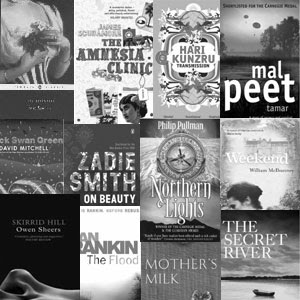 Book/Daddy's Jerome Weeks posts a thoughtful review of Faint Praise: The Plight of Book Reviewing in America by Gail Pool. The book is not, Weeks says, "a response to the recent cutbacks in book pages, nor a quarrel with critics' judgments nor a gripe about how dumbed-down everything has become." It is, rather, "a very commonsensical, clear-headed and knowledgeable analysis of the current state of professional book reviewing." Selected comments by Weeks:
Book/Daddy's Jerome Weeks posts a thoughtful review of Faint Praise: The Plight of Book Reviewing in America by Gail Pool. The book is not, Weeks says, "a response to the recent cutbacks in book pages, nor a quarrel with critics' judgments nor a gripe about how dumbed-down everything has become." It is, rather, "a very commonsensical, clear-headed and knowledgeable analysis of the current state of professional book reviewing." Selected comments by Weeks:On advertising in book pages:
"Ms. Pool believes that publishers are at considerable fault (although hardly solely at fault) for the current straits many newspaper book pages and literary journals are in because of the industry's unwillingness to provide advertising support....This presupposes, however, that publishers have the money to do this, when, in fact, publishing has notoriously low profit margins. Which is why the corporate pressure of recent years to get and keep those margins above 10 percent has twisted many houses into bestseller factories. It also assumes that, at some time, publishers did provide such money. But as I've argued before... newspaper book reviews have never made money. So the cutbacks in book pages have to do with a much wider loss of ad revenue for newspapers than the pittance that publishers traditionally have provided. One would certainly like publishers to provide more advertising, but the current sorry state of book pages is the result of newspaper owners choosing to let their more literate readers suffer by chucking book reviews overboard. Or they feel the literate ones have long since abandoned ship, anyway."On the realities of the editorial hierarchy at newspapers:
"Journalists haven't devoted book-length studies to reviewing because, like so much in the press, it's viewed more as a craft, as something aimed at Any Straphanger with a 5th Grade Education, than something needing or deserving intellectual consideration. It's still the case at many newspapers that pop music critics and video game critics, for example, are chosen among the youngest, most inexperienced staff members because, presumably, they're more 'in touch with the young folks.' [Weeks is a fairly young guy himself, 'though not as young as the 'young folks.']. And besides, that's all the subjects are worth. It'll keep those staffers away from the important, influential, thoughtful, Pulitzer-winning stuff. Like writing editorial columns getting the Iraq War wrong."On the value of book pages to the public and to newspapers:
"In any event, the newspaper book page is worth fighting for, worth arguing about like this, because the Big City Daily remains the only American medium dedicated to providing a decent level of professional book criticism from a number of sources addressing a general but local audience -- and all for a pretty cheap price. Commercial TV and radio do nothing like it, even public television and radio are pretty slack on the job. Magazines are too small in circulation, too narrowcast yet too scattered. Book blogs are a fascinating new medium but they are certainly preaching to the converted. As cumbersome and faulty and cozily middle-brow as the newspaper book page is, it remains one of the best efforts (one of the only efforts) to engage a city's readers in a common discussion about books and book issues, to lead them beyond personal interests to something new or different in literature. The book page can also advocate for literacy and libraries and education -- all the things that newspaper managements, if they had any brains, would see are vital to their own continuance."As always, check out the National Book Critics Circle's Campaign to Save Book Reviews for information about recent cutbacks in book coverage and book pages, and how you can get involved.
7.25.2007
"Mona Lisa Descending a Staircase"
7.24.2007
The Internet Is Not The Problem
 Because I've become concerned about the continuing loss of arts -- in particular, book -- coverage in metropolitan newspapers, I've been reading more about the management of newspapers. This is a topic I knew -- and still know -- little about, and it's proving to be an enlightening education. In a review very much worth reading in The New York Review of Books, Russell Baker takes a look of the state of journalism today. Discussing The New York Times, The Washington Post, and The Wall Street Journal (the WSJ's owners, the Bancroft family, has put the paper up for sale. See here, here and here for the ongoing story), Baker writes:
Because I've become concerned about the continuing loss of arts -- in particular, book -- coverage in metropolitan newspapers, I've been reading more about the management of newspapers. This is a topic I knew -- and still know -- little about, and it's proving to be an enlightening education. In a review very much worth reading in The New York Review of Books, Russell Baker takes a look of the state of journalism today. Discussing The New York Times, The Washington Post, and The Wall Street Journal (the WSJ's owners, the Bancroft family, has put the paper up for sale. See here, here and here for the ongoing story), Baker writes:"Family control has sheltered all three newspapers from Wall Street's most insistent demands, allowing them to do high-quality—and high cost— journalism. It was said, and widely believed, that the controlling families were animated by a high-minded sense that their papers were quasi-public institutions. Of course profit was essential to their survival, but it was not the primary purpose of their existence. That one of these families might finally take the money and clear out heightens fears that no newspaper is so valuable to the republic that it cannot be knocked down at market for a nice price. Murdoch at the Journal is a dark omen for journalists everywhere. When the sign in the shop window says "Everything For Sale," it is often followed by 'Going Out Of Business.'and of the results when the stock market bubble burst in the early 2000's, he says:
Journalism was being whittled away by a Wall Street theory that profits can be maximized by minimizing the product. Papers everywhere felt relentless demands for improved stock performance. The resulting policy of slash-and-burn cost-cutting has left the landscape littered with frail, failing, or gravely wounded newspapers which are increasingly useless to any reader who cares about what is happening in the world, the country, and the local community. Cost-cutting has reduced the number of correspondents stationed abroad, shriveled or closed news bureaus in Washington, and crippled local reporting staffs which once kept an eye on governors, mayors, state legislatures, small-town rascals, crooks, and jury suborners. It has also shrunk the size of the typical newspaper page, cutting the cost of newsprint by cutting news content.Baker gives little credence to the argument that the Internet is the great enemy of print publishing, suggesting, in fact, that it should make for better journalism. He puts the blame squarely on corporate management, who has moved newspapers' responsibility away from its publics and to its shareholders.
At Book/Daddy, Jerome Weeks, noting Baker's article, says:
"...So the next time a newspaper announces [that] it's trimming or killing book reviews, remember: It's not because of New Media, it's not rising illiteracy, it's not from any purported loss in advertising from the publishing industry. The cutback is the direct result of management decisions on what to value, which readers to sacrifice, how to please Wall Street."Finally, on a more humorous, but not unrelated note, here's the beginning of Leonard Pitt's recent column, "No Escape in the Era of Viral Knowledge," retitled "Harry Potter Hype is Impossible to Ignore" for my local paper. Pitts is a Pulitzer Prize-winning columnist for The Miami Herald, which was my local paper for quite a while, and considered one of the best newspapers in the country. The Knight family sold the paper last year, and Pitts makes a not-so-subtle allusion to what may be going on as a result (besides the fact that the first item in the online banner-below-the banner today is "Holy Cow: bovine loose in Miami Lakes"):
"Harry Potter dies in the new book. It's tragic, really. Accidental cauldron explosion. Eye of newt and wing of bat everywhere. He gets impaled by a flying dragon snout. His last word is: 'Rosebud.'
"OK, I made that up. Please stop shrieking now. And for heaven's sake, don't cancel your subscription. We only have 17 subscribers left, and there's a rumor that if we lose one more, it'll be the end of free soap in the lavatories."If you want to find out what's been happening to book coverage of late, and how you can help stem the tide, check out the National Book Critics Circle's Campaign to Save Book Reviews here.
7.22.2007
Fun Books
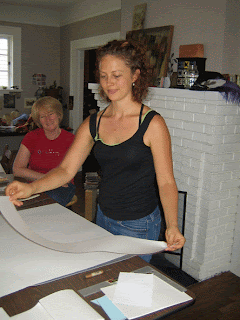 I spent yesterday making a fun book at Annie Fain Liden's studio. I met Annie Fain a little over a year ago when I'd been making books for only a short time. To say that she's a multi-talented young woman is putting it mildly. In addition to making books and teaching book arts classes, she's an accomplished Morris dancer, plays fiddle and banjo --among other instruments-- and weaves and sews. She grew up in Murphy, NC, next door to the John C. Campbell Folk School, where her mother, Martha Owen, is the Folk School's Resident Fiber Artist. This spring, Annie Fain spent two months at Penland as the studio assistant in the weaving program and just returned from teaching a week-long book arts class at the Campbell Folk School. (That's AF to the right with Priscilla, one of my classmates, in the background.)
I spent yesterday making a fun book at Annie Fain Liden's studio. I met Annie Fain a little over a year ago when I'd been making books for only a short time. To say that she's a multi-talented young woman is putting it mildly. In addition to making books and teaching book arts classes, she's an accomplished Morris dancer, plays fiddle and banjo --among other instruments-- and weaves and sews. She grew up in Murphy, NC, next door to the John C. Campbell Folk School, where her mother, Martha Owen, is the Folk School's Resident Fiber Artist. This spring, Annie Fain spent two months at Penland as the studio assistant in the weaving program and just returned from teaching a week-long book arts class at the Campbell Folk School. (That's AF to the right with Priscilla, one of my classmates, in the background.)
Locally, Annie Fain (it's a double name, like "Mary Jane" or "Ann Marie") teaches bookmaking in her studio and at BookWorks. She has an engaging, supportive and relaxed teaching style that makes working with her a pleasure. This session's project was a whimsical two-in-one coptic-binding book that opens via side-by-side "doors." Open, the book has the feel of an altar or shrine. We used book board for the back of the book, and covers from old books for the front covers. Part of the fun was deciding how to treat both the outer and inside panels of the book. One of the students opted for textural paper for the outside of the book and collaged the inside panels; another kept the covers pristine but used images on the inside back cover that created the effect of a stage; I used decorative paper for most of the book and acrylic paint and ink on the front covers.

I like the conceit of the book. Unlike a dos-a-dos structure, which also creates two books, but back-to-back, the side-by-side book allows -- in fact, encourages -- a relationship between the facing text blocks. I'd like to spend a little time deciding how best to use my book. But not too long.
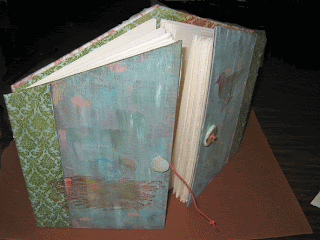
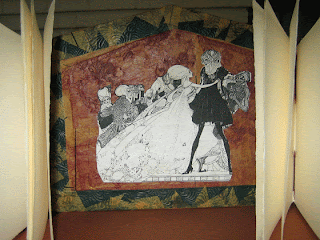
7.19.2007
Bibliokinetics
 I've been thinking about pop-up books lately. In a couple of weeks I'll be heading to Arrowmont for a class with book artist Carol Barton, who's known for her skill in paper engineering. And yesterday I stopped in at BookWorks and found a pop-up book class in full session. Led by the very talented designer and book artist Shawn Sheehy, adjunct faculty of book arts at Columbia College in Chicago (the wonderful Audrey Niffeneger is also on the faculty there), the class was creating magical structures that made me wish I had signed up for Shawn's class AND Carol Barton's. (That's one of Shawn's pieces above, part of a book of fabulous creature constructions he has on exhibit at BookWorks this week.)
I've been thinking about pop-up books lately. In a couple of weeks I'll be heading to Arrowmont for a class with book artist Carol Barton, who's known for her skill in paper engineering. And yesterday I stopped in at BookWorks and found a pop-up book class in full session. Led by the very talented designer and book artist Shawn Sheehy, adjunct faculty of book arts at Columbia College in Chicago (the wonderful Audrey Niffeneger is also on the faculty there), the class was creating magical structures that made me wish I had signed up for Shawn's class AND Carol Barton's. (That's one of Shawn's pieces above, part of a book of fabulous creature constructions he has on exhibit at BookWorks this week.)Su Blackwell is a UK-based artist whose work with books is part pop-up book, part papercutting and part fairy tale. Her three-dimensional "book-cut sculptures" are delicate and mysterious, and some are darker upon reflection than they appear at first glance. From her web site:
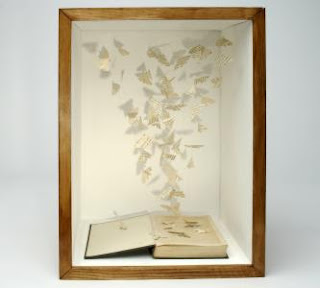
The Quiet American, 2006
"In a way, Su Blackwell's book-cut sculptures are very similar to receiving a marked-up copy of a book from a friend. Their particular interpretation of the text is privileged for your consideration and you can re-evaluate your response to the work through the lens of their relationship. It's like turning books into memories.
" her reconstruction offers up to the viewer many questions. We can no longer physically read the book, so in that way it is made redundant; and yet on another level it has taken on a new life and is telling a different story. Her work gives a new dimension to the rich European tradition of storytelling..."
And Blackwell says:
"The wear on my books, as physical objects, holds their history and makes my relationship with their contents immediate and visceral. The books I carry when I travel get stained and frayed, and the damage tells a story. I love second-hand books that have been marked up with pencil because I can see what was important to the person who read it before me."
7.17.2007
NoOne's Not Writing About Harry
Is there any newspaper on the planet that isn't running a Harry Potter story this week? The bigger question is whether we'll be reading anything different from what we read when the other books in the series were published. So far, I'd have to say that the answer to both questions is "no."
Last Sunday, Ron Charles, senior editor of the Washington Post's "Book World," joined the parade in his article, "Harry Potter and the Death of Reading." He cited some of the depressing statistics that we've heard regularly from others on his side of the Potter debate:
- A 1994 study by Alan Sorensen at Stanford University reported that "in 1994, over 70 percent of total fiction sales were accounted for by a mere five authors." (It's hard to imagine that the statistics have improved since then.)
- In 2004, the National Endowment for the Arts released Reading at Risk: A Survey of Literary Reading in America, which gauged the reading habits of America from 1982 to 2002. People were asked whether, over the past12 months, they had read any part of a novel, short story, poem, or play, excluding anything read for work or school. If they'd read the first two pages of, say, "Mandingo," (BookGirl refuses to link to this), the survey considered them literary readers. The results? The proportion of Americans reading "literature" declined from 56.9 percent in 1982 to 46.7 in 2002.
Understandably, Charles finds the diminishing number of readers of fiction discouraging, and he's equally disheartened by the people who tell him "I don't read fiction...I have so little time nowadays that when I read, I like to learn something." (Coincidentally, someone said virtually the same thing to BookGirl last week. One possible implication, with is so silly that BookGirl can't take offense, is that BookGirl, who reads mostly fiction, isn't interested in learning anything. The other, more important, implication is that one doesn't learn anything from reading fiction. This one does offend BookGirl.)
But Charles's main point is that the Harry Potter phenomenon isn't about reading at all, but about marketing. Being a Potter-Head, suggests Charles, is less about a gratifying personal experience with a book, and more about the experience of homogenization: becoming like every other Potter-Head:
"Perhaps submerging the world in an orgy of marketing hysteria doesn't encourage the kind of contemplation, independence and solitude that real engagement with books demands -- and rewards. Consider that, with the release of each new volume, Rowling's readers have been driven not only into greater fits of enthusiasm but into more precise synchronization with one another. Through a marvel of modern publishing, advertising and distribution, millions of people will receive or buy "The Deathly Hallows" on a single day. There's something thrilling about that sort of unity, except that it has almost nothing to do with the unique pleasures of reading a novel: that increasingly rare opportunity to step out of sync with the world, to experience something intimate and private, the sense that you and an author are conspiring for a few hours to experience a place by yourselves -- without a movie version or a set of action figures. Through no fault of Rowling's, Potter mania nonetheless trains children and adults to expect the roar of the coliseum, a mass-media experience that no other novel can possibly provide."This was the only genuine insight in Charles's article, although his implication that a kid would want to "step out of sync with the world," rather than be just like every other kid, seems naive. And while I agree with Charles's premise, I'm also certain that there are those who read Harry Potter books not because they want to run with the pack, but simply because they're drawn to the genre and/or enjoy the characters and plot and want to see them develop.
Frankly, I don't understand why people feel that they need to take sides on Potter. I'm delighted to see kids pick the books up, and like many other adults, I bought one for a child whom I hoped to entice into reading more often. In fact, if the Potters get anybody -- including adults -- reading, I'm thrilled. Charles, on the other hand, is distressed that adults are reading Harry Potter instead of books he considers better entries in the fantasy category, such as "Jonathan Strange and Mr. Norell" by Susanna Clarke and Philip Pullman's "His Dark Materials."
I appreciate Charles's point that there are many, many deserving books that sell many, many, many (add about 100 more "manys" here) fewer copies than the Potter series, and this makes me sad. Unfortunately, for those who read the Potters for the reasons Charles outlines, neither Clarke's nor Pullman's books would fill the need that the Potters satisfy.
So if folks want to dash down to their favorite neighborhood bookstore dressed as -- whomever --- to celebrate the publication of the latest Potter, more power to them! Who knows, maybe they'll walk out with another book in addition to the one they've long been anticipating (BookGirl is feeling particularly optimistic today).
7.16.2007
Mia Leijonstedt's Books
7.14.2007
Circle Accordion Mock-Up
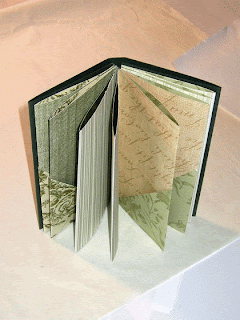 I spent some time yesterday in my studio working on a book -- finally!. The result was a small mock-up ( 3 " x 6") of a circle accordion in one of Alisa Golden's books. It's a simple structure : an accordion attached to covers. The covers are attached in such a way that when the book is fully open it forms a modified circle. My variation includes 2 sections with pockets, alternating with two sections without.
I spent some time yesterday in my studio working on a book -- finally!. The result was a small mock-up ( 3 " x 6") of a circle accordion in one of Alisa Golden's books. It's a simple structure : an accordion attached to covers. The covers are attached in such a way that when the book is fully open it forms a modified circle. My variation includes 2 sections with pockets, alternating with two sections without.I used Canson cover-weight for the cover and some left-over decorative papers for the pages. My only revision to Golden's instructions -- besides the size -- was to use paper strips rather than linen tapes to attach the sections to each other and to the cover.
I enjoyed this so much that I may start working my way through the book, making a collection of mock-ups, then choosing the structures I like best for the next step.



7.13.2007
Book Meme
Science Fiction, Fantasy or Horror? I've never been drawn to science fiction or horror. If I had to pick, I'd choose fantasy, since there's a lot of leeway in how "fantasy" can be defined. Book Dragon, for example, mentions magical realism.
Hardback or Trade Paperback or Mass Market Paperback? There's something about the trade paperback that calls to me. They're simply more tactile than hardbound books and, of course, easier to carry around. That's important, since I never leave the house without a book.
Amazon or Brick and Mortar? I'd always rather be in a bookstore and always rather peruse books in person. Having said that, Amazon makes it sooooooo easy to find what you want -- and the pricing helps when you're buying art books and book arts books. (Now, say that really fast five times).
Barnes & Noble or Borders? Much as I like independent bookstores and frequent them, Barnes & Noble was one of the first, with its cafes and lounging areas, to create an atmosphere where customers could sit and peruse books, which is a good thing. They get some credit for that, and you'll see me there from time to time.
Hitchhiker or Discworld? Neither, but I do recall reading Hitchhiker years ago -- or was it the t.v. show? Hmmmmmm.
Bookmark or Dogear? Dogear? Never. If I don't have a proper bookmark, I'll use anything available -- a napkin, a leaf, a ticket stub. I actually have very nice bookmarks that people have given me over the years, but, mostly, I end up with the ones I pick up at bookstores.
Asimov's Science Fiction, or Fantasy and Science Fiction? Neither, although I've read the former and like what I read.
Alphabetize by author, Alphabetize by title, or random? I don't alphabetize. Instead, I group by genre. My husband, who alphabetizes within genre, is aghast.
Keep, Throw Away or Sell? I keep books that are meaningful to me or that I simply loved reading. I never throw books out. Instead, I either sell them on Amazon, or I donate them to my local library. My husband, when I met him, possessed every book he'd read since the age of 3; under my benevolent influence, he now has only every book he's read since the age of 12.
Keep dust-jacket or toss it? Keep. But really, who cares (Who cares?Aaaaaaarggggggggh! says my husband)?
Read with dustjacket or remove it? On. Like Book Dragon, I occasionally use the front flap as a bookmark.
Short story or novel? I prefer novels; I also like essays about books and reading -- Anne Fadiman's are excellent.
Harry Potter or Lemony Snicket? I didn't find the first Harry Potter very compelling (so sue me), and quit while I was ahead. I did read a couple of the Snickets.
Stop reading when tired or at chapter breaks? It's easier to pick up your train of thought when you've stopped at the end of the chapter, but I'm not, you know, religious or anything about it.
"It was a dark and stormy night" or "Once upon a time?" Definitely the former. Although it's hard for me to read that line now without seeing Snoopy.
Buy or Borrow? I don't like to borrow from friends, because I'm never quite sure when the mood's going to strike me to read a book, and also because I feel a bit of a responsibility to the person I borrowed it from to like the book (hugely neurotic, I know). I'm borrowing more than ever from my library these days, and electronic renewal has made that much easier. And, yes, I buy. And buy. And buy.
Buying choice: Book Reviews, Recommendation or Browse? Book reviews and browsing in equal measure. Recommendations less so.
Lewis or Tolkien? I'm assuming that the reference here isn't to Lewis's theological writing. In any case, neither. I'm really striking out on these author categories, aren't I?
Collection (short stories by the same author) or Anthology (short stories by different authors)? I'd rather read a collection of stories by one writer. It's fun to troll for recurring themes.
Tidy ending or Cliffhanger? Tidy endings can be very satisfying, of course, but since life isn't very tidy, open-ended endings resonate more.
Morning reading, Afternoon reading or Nighttime reading? My dream job would be Professional Reader. Not a book critic, not a book editor or publisher, nothing that required me to do anything with what I'd read other than enjoy it (or not). I can read any time, anywhere, but I read more in the afternoons and before bed.
Standalone or Series? The only "series" I truly enjoy are mystery series. Mysteries lend themselves well to continuing characters, and there's a certain comfort in continuity. I'd guess that about every fourth book I read is a mystery. It's like a sorbet between courses.
New or used? Both, but I don't want to read something that looks like the dog's chew toy. Have some respect for your books, please!
Favorite book of which nobody else has heard? I honestly don't know how well-known Sarah Caudwell is (sadly, she died in 2000) but I love the dry humor of her charming legal whodunit series: The Shortest Way to Hades, Thus was Adonis Murdered, The Sirens Sang of Murder, and The Sybil in Her Grave. For some reason, I have a thing for British women writers -- Muriel Spark, P.D. James, Penelope Lively, Penelope Fitzgerald. Someday I'll have to get that taken care of.
Top 5 favorite genre books of all time? Well, if you consider "literary fiction" (I hear my husband snorting now), then I can play. Even so, there's no way I can list a definitive five books, simply because I'd obssess, anxious that I'd left out THE book. Let's just say that I love these books among many others: Pride and Prejudice, The Amazing Adventures of Kavalier & Clay, The Great Gatsby, One Hundred Years of Solitude, and Alice in Wonderland.
Favorite genre series? I loved The Borrowers series as a child, and still do. Now, P.D. James's Adam Dalgliesh series comes to mind.
Currently Reading? No One Belongs Here More Than You, by Miranda July; Suite Francaise, by Irene Nemirovsky; Special Topics in Calamity Physics, by Marisha Pessl; and dipping, for what seems like an eternity (not that there's anything wrong with that), into The War Against Cliches, by Martin Amis.
7.12.2007
Book Lust
It's naive to think that these bloggers and I are kindred spirits, but I'm enough of a romantic to think that readers and book lovers do connect in some significant and fundamental way. (To those who would write BookGirl to say that she's wrong and thereby destroy her carefully nurtured illusion, she would prefer that you didn't.)
English is my second language. I have a vivid memory of my first grade classroom in the U.S. I received a mimeographed sheet with a series of illustrations and several words underneath each one. My classmates and I were told to circle the one word that best described the corresponding picture. At least I think that was our assignment. In any case, not knowing any English, I colored in the pictures and handed in my sheet. How I made it to second grade is still a mystery. Was it my proficiency in arithmetic? My good behavior? If so, the math skills diminished at a steady pace between grade school and college, and my behavior deteriorated once I learned enough English to speak to the student across the aisle.
My strongest memory of second grade is the reading class. There was a large box with color-coded tabs on the teacher's desk. Each tab corresponded to reading material that was appropriate to a specific reading level. By then I knew enough English to understand that the color-coded materials were used to assess the reading level of each student, who was then assigned to a peer reading group. Somehow, I managed to land in the top-level reading group by the end of the year.
At home I spoke the language of my native country, since my parents never learned to speak fluent English. But with their encouragement, and that of the teacher who helped me get my first library card, I became quite the library rat. I didn't get much guidance on reading material, though, so I was wonderfully, wildly, indiscriminate in my choices.
Other readers' backgrounds may be very different from mine (although I expect some are similar), but I like to think that we share an enthusiasm -- is it too much to call is a passion? -- that's difficult to explain if you haven't experienced it, but fairly simple to recognize in someone else if you have.
I guess it's not surprising that I'd take up book arts -- as in bookmaking -- and that I enjoy it as much as I do. And although I've been reading much much longer than I've been making books, I sense that there's an affinity among bookmakers similar to the one I've experienced among readers. I'm loving being part of another cool community that cares about books.
7.11.2007
Let's Hope He's Wrong
7.09.2007
Arts Coverage and Artblogging
Teachout disagrees with Schickel about the value of artbloggers, noting that some of the most thoughtful and informed writing about the arts appears in blogs (Note: the thougtful and informed bloggers he mentions are, in fact, journalists who happen to blog about their subject- e.g., Tyler Green, who blogs on the visual arts at Modern Art Notes, and Teachout himself.) Teachout does admit a distinction, though:
"One of the most important civic duties that a newspaper performs is to cover the activities of local arts groups -- but it can't do that effectively without also employing knowledgeable critics who are competent to evaluate the work of those groups. Mere reportage, while essential, is only the first step. It's not enough to announce that the Hooterville Art Museum finally bought itself a Picasso. You also need a staffer who can tell you whether it's worth hanging, just as you need someone who knows whether the Hooterville Repertory Company's production of "Private Lives" was funny for the right reasons.I couldn't have said it better myself, which is why I quoted Teachout instead. So, folks, as I've said before (click here for a recent post), if you're interested in getting involved in stemming the tide, join the National Book Critics Circle Campaign to Save Book Reviewing by clicking here.
"...blogging, valuable though it can be, is no substitute for the day-to-day attention of a newspaper whose editors seek out experts, hire them on a full-time basis, and give them enough space to cover their beats adequately. The problem is that fewer and fewer newspapers seem willing to do that in any consistent way. I don't care for the word "provincial," but I can't think of a more accurate way to describe a city whose local paper is unwilling to make that kind of commitment to the fine arts.
"...I got my start reviewing second-string classical concerts for the Kansas City Star 30 years ago. Now that such entry-level jobs are drying up, I fear for the future of arts journalism in America."
Experimenting with Image Transfers
I've been experimenting with a process (and product: Omni Gel) that leaves you with an acrylic film that you then apply to your chosen medium (so far I've used the transfers only on fabric and paper). I used PVA to adhere the transfers, but I could have used other methods, such as stitching. After trying various papers and fabrics to back the images, here are the combinations that were the most successful. Here's what I learned from this experience (no doubt there are exceptions to these guidelines, but they were useful to me in this instance):
- I had the best result using images with simpler lines and larger blocks of white/light backgrounds. This allows the pattern/color of the substrate to which you apply it to be seen through the transfer.
- Smaller, repeated patterns on the substrate -- your fabric or paper -- worked well. Patterns that were too larger or two spaced apart were lost when I laid the transfer over them.
- A substrate with lighter colors worked best.
 This is a transfer onto fabric. This image has quite a lot of white in it, so the pattern of the fabric shows through well. It's less important with this type of image that the pattern in the substrate be small and regular. In fact, it's not.
This is a transfer onto fabric. This image has quite a lot of white in it, so the pattern of the fabric shows through well. It's less important with this type of image that the pattern in the substrate be small and regular. In fact, it's not. Another image on the same fabric. Again, the image has the qualities of a pen and ink illustration, so there is a good amount of "white space" that serves to make portions of the image transparent.
Another image on the same fabric. Again, the image has the qualities of a pen and ink illustration, so there is a good amount of "white space" that serves to make portions of the image transparent.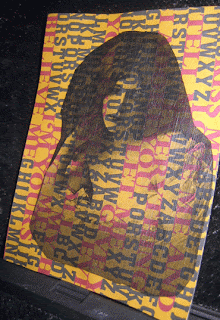 Here's an example of an image that has some very dark areas (the woman's hair), so that portion of the image is fairly opaque. There's also the question of whether the image and the substrate work well together, and I wasn't thinking much about that during this experiment. One one level, these don't go together well at all; but if contrast was your intention...
Here's an example of an image that has some very dark areas (the woman's hair), so that portion of the image is fairly opaque. There's also the question of whether the image and the substrate work well together, and I wasn't thinking much about that during this experiment. One one level, these don't go together well at all; but if contrast was your intention...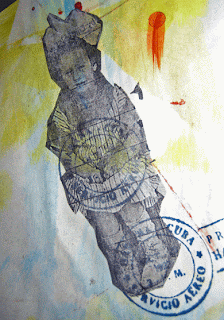 The paper to which the image is adhered was the scrap paper covering my table. There were some images stamped on it, and I wanted to see how those would show through.
The paper to which the image is adhered was the scrap paper covering my table. There were some images stamped on it, and I wanted to see how those would show through. Paper again. See the lines/grid on the image. When I printed the image, in error I had put paper in the printer that had already been printed on. So the image of the girl overprinted on paper that had an insurance claim form on it. Happy or unhappy accident? Depends on how I end up using the image.
Paper again. See the lines/grid on the image. When I printed the image, in error I had put paper in the printer that had already been printed on. So the image of the girl overprinted on paper that had an insurance claim form on it. Happy or unhappy accident? Depends on how I end up using the image. This too is an image adhered to paper. As with the image above, this one overprinted on another sheet of "claim form" paper.
This too is an image adhered to paper. As with the image above, this one overprinted on another sheet of "claim form" paper.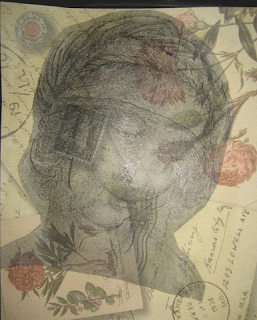 This paper clearly doesn't have a small or regular pattern on it. Nevertheless, it worked well, in part because this is a large image (about 5 inches in height).
This paper clearly doesn't have a small or regular pattern on it. Nevertheless, it worked well, in part because this is a large image (about 5 inches in height).It'll be fun figuring out how to incorporate these into my book work.
7.05.2007
Doing
As with most things in life, this issue has two sides. The other side is that I'm a learning junkie. There's little else that I prefer over learning. And, boy, was the Web ever made for someone like me. I can dig as deeply as I have time to spare into any and all topics that strike my fancy. Interesting details surface that enrich what I already know, and altogether new and fascinating subjects emerge -- all the time. The Web was made for inquisitive and curious people; and for procrastinators.
Making art is the big thing outside my comfort zone these days. Inspiration is everywhere -- on the Web and off. When I was working at BLF (Big Law Firm), I could work for twelve hours straight without skipping a beat. Part of it was my nature, and part of it, admittedly, was that there was always something more to be done, but a lot of it was the mastery I felt in what I was doing. Doing something I know how to do well feels terrific -- almost as good as learning.
But the type of art I'm exploring now -- working with paint and ink, combining fabric and paper, manipulating digital images -- brings no sense of mastery with it. I'm starting from scratch, and while a certain amount of R&D is good under the circumstances, too much can paralyze. It can even fool you into believing that you're doing something. And the clincher: I don't even know if I'm going to like what I'm doing even when (and if) I learn to do it well.
What's the solution? I'm not sure there is one. In any case, not a quick or easy one. Getting comfortable with what I'm doing is the only solution that truly makes sense. And you get comfortable by doing. I know this. I KNOW this. So I suppose this post is, more than anything, a public pep talk. Studio time first thing in the morning, regularly. Got that? You heard it here first.
And What Does It Get Us?
I've been posting over the past few months about the recent cuts in book sections and book coverage in various metropolitan dailies -- and as a result, the firing of respected book critics -- here, here, here, and here. Arts coverage (including book reviews) is often the first to be hit, but this story makes it clear that it's not the only area affected by the panic afflicting some newspapers, whose strategy seems to consist of firing as many journalists as they can to lessen their costs. Instead of looking for new and untrammeled paths around the admittedly tough issues caused by digital competition, they seem to be destroying what readers turn to newspapers for (see Mark Bowden's article on the gap that newspapers fill). Flournoy and Everbach, both in their interviews and hard analysis of the Dallas Morning News' content, paint a disturbing picture of the effects of this behavior.
Have the Morning News' actions translated into more readership (or at least more satisifed readers)? Hardly. From October 2006 through March 2007, the daily circulation of the paper suffered a decline of 14.3% compared to a year earlier. This is more than twice the decline of any other large newspaper. And reader satisfaction has fallen 19%, according to the latest survey.
Esther Thorson, an associate dean at the University of Missouri's School of Journalism, whose recent study examined four years of financial data at hundreds of newspapers, and who has studied media for 20 years, says that "those who try to cut the newsroom to maintain profitability are doomed to failure."
“'That’s not a business model,' she says. 'That’s a death model.' Thorson found that larger newsroom investments would translate into greater profits. 'A newspaper is a rich environment of information and entertainment,' she said. 'That makes it a fabulous locale for advertising. But if your product is degraded and circulation plummets, why would advertisers want to invest in that?'"Gee, even someone without my background in marketing can figure that one out.
Meanwhile, back on the arts desk these days, the Dallas Morning News has no architecture critic, no television critic, and no book critic.
(For information about the National Book Critics Circle Campaign to Save Book Reviewing, and how you can get involved, click here.)
7.03.2007
Helvetica, The Film!
I already know I'm going to love this film. In fact, I'm going to suggest it to our local art film/indie film/welcome-option-to-schlock film house. I recognize that it's a long shot (even this good film venue may not consider this a likely revenue-generating proposition), but then again, how could you not be interested in a film that Michael Phillips of the Chicago Tribune, in his review, describes thus:
"...the film says a great deal without raising its voice, lending wit and grace to an inquiry regarding the way a medium, a squiggle or the precise space between two letters affects a million different messages and a billion different eyeballs.Be still my heart.
"The real achievement of the picture, though, is the way it sharpens your eye in general and makes connections between form and content, and between art and life. By rounding up a great group of eloquent obsessives eager to explain their feelings about a font, Hustwit has come up with 80 unexpectedly blissful minutes."
Helvetica, by the way, is Latin for "Switzerland." Who knew?






